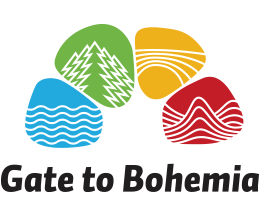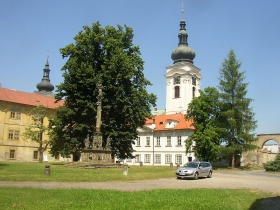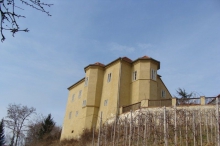The unique Monastery Complex in Doksany, the Renaissance Keep in Brozany nad Ohří and the ruins of a hunting manor called Windsor are the main attractions of this trip. The meandering River Ohře, the island of St. Kliment and the scenery of the Lower Poohří offer magnificent views of the dominant peaks of the Central Bohemian Uplands and give your journey another dimension.
Our route begins in Doksany, which historically dates back to 1144. At that time, the picturesque, yet marshy, meandering Ohře landscape attracted the establishment of a Premonstratensian monastery by Gertruda, the wife of Vladislaus II. However, the unstable history of the monastery led to its conversion into a chateau in 1782. The Baroque chateau complex is spread around four courtyards and is dominated by the former monastery, nowadays the parish and pilgrimage church of the Nativity of the Virgin Mary. A crypt with 47 pillars and an apse have remained preserved from the original Romanesque basilica. In the first courtyard we find a Marian Plague Column located behind a gorgeous baroque entrance and, in the second courtyard, a sculpture of the Virgin Mary on a globe. During the tour we can admire the lavish interior decor of the monastery church and its crypt, one of the most important Romanesque monuments in Bohemia. West of the monastery near the Castle Park we find the Mill, which is a technical monument. Those interested in architecture and history will certainly appreciate several Baroque farmhouses that are the remnants of a former mansion called “Terespol” which stood from 1796 to 1888.
From the Doksany crossroads, we take a minor road marked in red which guides us around the monastery. After walking across the bridge above the Ohře we enter Brozany, where our first attraction is the Renaissance Church of St. Gotthard. Inside the original Romanesque building are sandstone Renaissance monuments, which were saved by the sculptor F. Hnátek. Another monument here is a one-storey, Renaissance keep from the 16th century located on the ridge above the village. The keep can be reached either by a long staircase from the mill with a mansard roof; whose Renaissance rustic form of the 16th century has also remained preserved, or via an elevation separated from the keep by a deep trench. Today, the trench is spanned by a stone bridge. Our trip continues along the red track past family houses and then via a narrow road which takes us to the Island of St. Kliment. Above the river island, encircled by the main and secondary streams of the Ohře, is a 1180-metres long motorway bridge, which is the longest bridge of this kind in the Czech Republic.
From the village of Hostěnice, we take the road to Brozany and on the motorway flyover we can admire a breath-taking view of the Lower Poohří Natural Park with the unique carved valley of the Ohře, false channels and the remnants of lowland forests. We will then return to Brozany and turn left towards Chotěšov. The first steep climb is now ahead of us, but it is again crowned with lovely views from another motorway flyover. Chotěšov is a charming village with an elongated village square dominated by the Church of the Assumption of the Virgin Mary. One can, however, avoid the village by turning right at the crossroads with the road Nr. 247 and heading in the direction of Lovosice. The next six km sees only one undemanding hill climb near the village of Vrbičany, over which we can again take delight in beautiful views of the Bohemian Central Uplands.
Upon reaching Střezivojice we turn right, and just before the D8 motorway underpass we can see the ruins of a former hunting mansion called “Windsor”. Windsor, sometimes known as “Větrák”, is the ruin of a windmill which was later a hunting mansion. The original Dutch type windmill was built in 1843 from local light marlstone and bricks. The building had a circular layout with an approximate height of 12 m and a diameter of 8.5 meters. The windmill was used for milling until 1870, when the owner changed and the building was rebuilt into a neo-Gothic folly. The new owner, however, went bankrupt shortly after and since then this interesting building has fallen into disrepair. There ruin is accessible via a field road.
From the motorway we then continue around Humenský Hill and its transmitting station towards the village of Keblice. The village is renowned for its archaeological findings coming from the Palaeolithic Stone Age and several walled rural baroque buildings with gates and gables that have remained preserved. We will pass the Neo-Gothic church of St. Wenceslas and head further into the fields towards Brňany. In the village we will see a Manor House built in the 2nd half of the 18th century, with an extension on the eastern side in Art Nouveau style. We can also see a chapel of Sorrows of the Virgin Mary and John of Nepomuk from 1723. This part of our trip leads us along the borders of the Lower Poohří Nature Park, which can be further explored along the track beside the Ohře River. A convenient road runs between Brňany and Brozany nad Ohří. A more adventurous option takes you from Brňany around the manor house to the track and along the Ohře to the bridge between Brozany and Doksany.




































